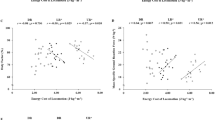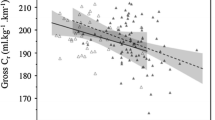Abstract
Purpose
The effect of trail running competitions on cost of running (Cr) remains unclear and no study has directly examined the effect of distances in similar conditions on Cr. Accordingly, the aims of this study were to (i) assess the effect of trail running races of 40–170 km on Cr and (ii) to assess whether the incline at which Cr is measured influences changes in Cr.
Methods
Twenty trail runners completed races of < 100 km (SHORT) and 26 trail runners completed races of > 100 km (LONG) on similar courses and environmental conditions. Oxygen uptake, respiratory exchange ratio, ventilation, and blood lactate were measured before and after the events on a treadmill with 0% (FLAT) and 15% incline (UH) and Cr was calculated.
Results
Cr increased significantly after SHORT but not LONG races. There was no clear relationship between changes in Cr and changes in ventilation or blood lactate. There was a significant correlation (r = 0.75, p < 0.01) between changes in FLAT and UH Cr, and the change in Cr was not affected by the incline at which Cr was measured.
Conclusion
The distance of the trail running race, but not the slope at which it is measured, influence the changes in Cr with fatigue. The mechanism by which Cr increases only in SHORT is not related to increased cost of breathing.




Similar content being viewed by others
Data availability
Data are available upon request.
Abbreviations
- ANOVA:
-
Analysis of variance
- Cr:
-
Cost of running
- Cr-breath:
-
Cost of running minus the energy cost of breathing
- FLAT:
-
Treadmill runner at 0% incline
- HR:
-
Heart rate
- [La−]:
-
Blood lactate concentration
- LONG:
-
Races longer than 100 km
- RER:
-
Respiratory exchange ratio
- SHORT:
-
Races shorter than 100 km
- UH:
-
Uphill treadmill running at 15% incline
- \(\dot{\text{V}}\) E :
-
Pulmonary ventilation
- \(\dot{\text{V}}\)̇O2max :
-
Maximal oxygen consumption
- WB:
-
Work of breathing
References
Aaron EA, Seow KC, Johnson BD, Dempsey JA (1992) Oxygen cost of exercise hyperpnea: Implications for performance. J Appl Physiol 72(5):1818–1825. https://doi.org/10.1152/jappl.1992.72.5.1818
Amann M, Blain GM, Proctor LT, Sebranek JJ, Pegelow DF, Dempsey JA (2010) Group III and IV muscle afferents contribute to ventilatory and cardiovascular response to rhythmic exercise in humans. J Appl Physiol 109(4):966–976
Balducci P, Clémençon M, Morel B, Quiniou G, Saboul D, Hautier CA (2016) Comparison of level and graded treadmill tests to evaluate endurance mountain runners. J Sports SciMed 15(2):239–246
Balducci P, Clémençon M, Trama R, Blache Y, Hautier C (2017) Performance factors in a mountain ultramarathon. Int J Sports Med 38(11):819–826. https://doi.org/10.1055/s-0043-112342
Björklund G, Swarén M, Born D-P, Stöggl T (2019) Biomechanical adaptations and performance indicators in short trail running. Front Physiol 10:506. https://doi.org/10.3389/fphys.2019.00506
Brueckner JC, Atchou G, Capelli C, Duvallet A, Barrault D, Jousselin E, Rieu M, di Prampero PE (1991) The energy cost of running increases with the distance covered. Eur J Appl Physiol 62(6):385–389. https://doi.org/10.1007/BF00626607
Candau R, Belli A, Millet GY, Georges D, Barbier B, Rouillon JD (1998) Energy cost and running mechanics during a treadmill run to voluntary exhaustion in humans. Eur J Appl Physiol 77(6):479–485. https://doi.org/10.1007/s004210050363
Coast JR, Rasmussen SA, Krause KM, O’Kroy JA, Loy RA, Rhodes J (1993) Ventilatory work and oxygen consumption during exercise and hyperventilation. J Appl Physiol 74(2):793–798. https://doi.org/10.1152/jappl.1993.74.2.793
Dempsey JA (2012) New perspectives concerning feedback influences on cardiorespiratory control during rhythmic exercise and on exercise performance. J Physiol 590(17):4129–4144. https://doi.org/10.1113/jphysiol.2012.233908
Ehrström S, Tartaruga MP, Easthope CS, Brisswalter J, Morin JB, Vercruyssen F (2018) Short trail running race: beyond the classic model for endurance running performance. Med Sci Sports Exerc 50(3):580–588. https://doi.org/10.1249/MSS.0000000000001467
Finni T, Kyröläinen H, Avela J, Komi PV (2003) Maximal but not submaximal performance is reduced by constant-speed 10-km run. J Sports Med Phys Fitness 43(4):411–417
Fletcher JR, Esau SP, MacIntosh BR (2009) Economy of running: beyond the measurement of oxygen uptake. J Appl Physiol 107(6):1918–1922. https://doi.org/10.1152/japplphysiol.00307.2009
Forster HV, Haouzi P, Dempsey JA (2012) Control of breathing during exercise. Compr Physiol 2(1):743–777. https://doi.org/10.1002/cphy.c100045
Franch J, Madsen K, Djurhuus MS, Pedersen PK (1998) Improved running economy following intensified training correlates with reduced ventilatory demands. Med Sci Sports Exerc 30(8):1250–1256. https://doi.org/10.1097/00005768-199808000-00011
Fusi S, Salvadego D, Bresadola V (2008) Maximal oxygen consumption and energy cost of running after a long-lasting running race: The 100 km of Sahara. Sport Sci Health 2(3):93–100. https://doi.org/10.1007/s11332-008-0046-6
Giandolini M, Vernillo G, Samozino P, Horvais N, Edwards WB, Morin J-B, Millet GY (2016) Fatigue associated with prolonged graded running. Eur J Appl Physiol 116(10):1859–1873. https://doi.org/10.1007/s00421-016-3437-4
Gimenez P, Kerhervé H, Messonnier LA, Féasson L, Millet GY (2013) Changes in the energy cost of running during a 24-h treadmill exercise. Med Sci Sports Exerc 45(9):1807–1813. https://doi.org/10.1249/MSS.0b013e318292c0ec
Gruber AH, Umberger BR, Braun B, Hamill J (2013) Economy and rate of carbohydrate oxidation during running with rearfoot and forefoot strike patterns. J Appl Physiol 115(2):194–201. https://doi.org/10.1152/japplphysiol.01437.2012
Hausswirth C, Bigard AX, Guezennec CY (1997) Relationships between running mechanics and energy cost of running at the end of a triathlon and a marathon. Int J Sports Med 18(5):330–339. https://doi.org/10.1055/s-2007-972642
Heigenhauser GJ, Sutton JR, Jones NL (1983) Effect of glycogen depletion on the ventilatory response to exercise. J Appl Physiol. https://doi.org/10.1152/jappl.1983.54.2.470
Hughes EF, Turner SC, Brooks GA (1982) Effects of glycogen depletion and pedaling speed on "anaerobic threshold". J Appl Physiol Respir Environ Exerc Physiol 52(6):1598–1607
Hunter I, Smith GA (2007) Preferred and optimal stride frequency, stiffness and economy: Changes with fatigue during a 1-h high-intensity run. Eur J Appl Physiol 100(6):653–661. https://doi.org/10.1007/s00421-007-0456-1
itra.run (2020). https://itra.run/content/definition-trail. Accessed 1 July 2020
Iannetta D, Inglis EC, Mattu AT, Fontana FY, Pogliaghi S, Keir DA, Murias JM (2019) A critical evaluation of current methods for exercise prescription in women and men. Med Sci Sports Exerc. https://doi.org/10.1249/MSS.0000000000002147
Kyrolainen H, Pullinen T, Candau R, Avela J, Huttunen P, Komi PV (2000) Effects of marathon running on running economy and kinematics. Eur J Appl Physiol 82(4):297–304. https://doi.org/10.1007/s004210000219
Lazzer S, Salvadego D, Rejc E, Buglione A, Antonutto G, Di Prampero PE (2012) The energetics of ultra-endurance running. Eur J Appl Physiol 112(5):1709–1715. https://doi.org/10.1007/s00421-011-2120-z
Lazzer S, Salvadego D, Taboga P, Rejc E, Giovanelli N, Di Prampero PE (2015) Effects of the Etna uphill ultramarathon on energy cost and mechanics of running. Int J Sports Physiol Perform 10(2):238–247. https://doi.org/10.1123/ijspp.2014-0057
Margaria R, Milic-Emili G, Petit JM, Cavagna G (1960) Mechanical work of breathing during muscular exercise. J Appl Physiol 15:354–358. https://doi.org/10.1152/jappl.1960.15.3.354
Millet G, Lepers R, Lattier G, Martin V, Babault N, Maffiuletti N (2000) Influence of ultra-long-term fatigue on the oxygen cost of two types of locomotion. Eur J Appl Physiol 83(4–5):376–380. https://doi.org/10.1007/s004210000313
Millet GY, Tomazin K, Verges S, Vincent C, Gis Bonnefoy R, Boisson RE-C, Gergelé L, Onard L, Asson F, Martin V (2011) Neuromuscular consequences of an extreme mountain ultra-marathon. PLoS ONE. https://doi.org/10.1371/journal.pone.0017059
Millet GY, Martin V, Temesi J (2018) The role of the nervous system in neuromuscular fatigue induced by ultra-endurance exercise. Appl Physiol Nutr Metab 43(11):1151–1157. https://doi.org/10.1139/apnm-2018-0161
Nicol C, Komi PV, Marconnet P (2007) Effects of marathon fatigue on running kinematics and economy. Scand J Med Sci Sports 1(4):195–204. https://doi.org/10.1111/j.1600-0838.1991.tb00296.x
Péronnet F, Massicotte D (1991) Table of nonprotein respiratory quotient: an update. J Canad Sci Sport 16(1):23–29
Schena F, Pellegrini B, Tarperi C, Calabria E, Salvagno GL, Capelli C (2014) Running economy during a simulated 60-km trial. Int J Sports Physiol Perform 9(4):604–609. https://doi.org/10.1123/ijspp.2013-0302
Shaw AJ, Ingham SA, Folland JP (2014) The valid measurement of running economy in runners. Med Sci Sports Exerc 46(10):1968–1973. https://doi.org/10.1249/MSS.0000000000000311
Thomas DQ, Fernhall B, Blanpied P, Stillwell K (1995) Changes in running economy and mechanics during a submaximal 5-km run. J Strength Cond Res 9(3):170–175
Vercruyssen F, Tartaruga M, Horvais N, Brisswalter J (2016) Effects of footwear and fatigue on running economy and biomechanics in trail runners. Med Sci Sports Exerc 48(10):1976–1984. https://doi.org/10.1249/MSS.0000000000000981
Vernillo G, Savoldelli A, Zignoli A, Trabucchi P, Pellegrini B, Millet GP, Schena F (2014) Influence of the world’s most challenging mountain ultra-marathon on energy cost and running mechanics. Eur J Appl Physiol 114(5):929–939. https://doi.org/10.1007/s00421-014-2824-y
Vernillo G, Rinaldo N, Giorgi A, Esposito F, Trabucchi P, Millet GP, Schena F (2015a) Changes in lung function during an extreme mountain ultramarathon. Scand J Med Sci Sports 25(4):e374–e380. https://doi.org/10.1111/sms.12325
Vernillo G, Savoldelli A, Zignoli A, Skafidas S, Fornasiero A, Torre AL, Bortolan L, Pellegrini B, Schena F (2015b) Energy cost and kinematics of level, uphill and downhill running: fatigue-induced changes after a mountain ultramarathon. J Sports Sci 33(19):1998–2005. https://doi.org/10.1080/02640414.2015.1022870
Vernillo G, Savoldelli A, Skafidas S, Zignoli A, La Torre A, Pellegrini B, Giardini G, Trabucchi P, Millet GP, Schena F (2016) An extreme mountain ultra-marathon decreases the cost of uphill walking and running. Front Physiol. https://doi.org/10.3389/fphys.2016.00530
Vernillo G, Millet GP, Millet GY (2017) Does the running economy really increase after ultra-marathons? Front Physiol 8:783. https://doi.org/10.3389/fphys.2017.00783
Wütrich TU, Marty J, Kerherve H, Millet GY, Verges S, Spengler CM (2015) Aspects of Respiratory Muscle Fatigue in a Mountain Ultramarathon Race. Med Sci Sports Exerc 47(3):519–527. https://doi.org/10.1249/MSS.0000000000000449
Xu F, Montgomery D (1995) Effect of Prolonged Exercise at 65 and 80 % of VO 2 max on Running Economy. Int J Sports Med 16(05):309–313. https://doi.org/10.1055/s-2007-973011
Acknowledgements
The authors thank all the subjects for their participation, Ultra-Trail du Mont Blanc® organization and National School of Ski & Mountaineering for logistical support. The authors would like to gratefully acknowledge the technical help provided Diana Rimaud and Audrey Parent. The authors thank Callum Brownstein for his help with proofreading the manuscript.
Funding
This research was funded by an IDEX Lyon fellowship.
Author information
Authors and Affiliations
Corresponding author
Ethics declarations
Conflict of interest
The authors do not have any conflict of interest that could inappropriately influence this work.
Ethical approval
Approval for the project was obtained from the French Ethical Research committee (Comité de Protection des Personnes Ouest VI). The study was registered at ClinicalTrials.gov (NCT04025138).
Informed consent
Informed consent was obtained from all participants included in the study.
Additional information
Communicated by Jean -Rene Lacour.
Publisher's Note
Springer Nature remains neutral with regard to jurisdictional claims in published maps and institutional affiliations.
Rights and permissions
About this article
Cite this article
Sabater Pastor, F., Varesco, G., Besson, T. et al. Degradation of energy cost with fatigue induced by trail running: effect of distance. Eur J Appl Physiol 121, 1665–1675 (2021). https://doi.org/10.1007/s00421-021-04624-5
Received:
Accepted:
Published:
Issue Date:
DOI: https://doi.org/10.1007/s00421-021-04624-5




